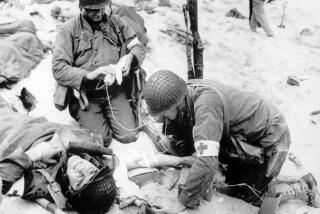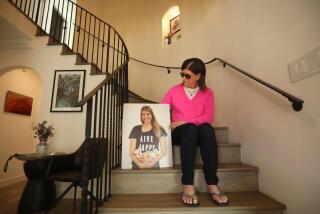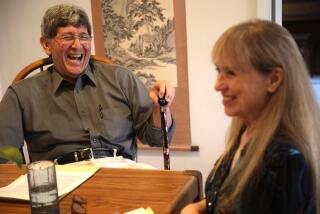A Medical Pioneer’s Many Firsts
- Share via
She was ravaged by tuberculosis, plagued by sexism and shunned even--perhaps especially--by colleagues. But Rebecca Lee Dorsey persevered to become a pioneer: the world’s first female endocrinologist and the first woman physician to practice in Los Angeles.
Throughout a medical career that spanned almost seven decades, according to her unpublished memoirs, Dorsey delivered 5,000 babies, among them future California governor and chief justice of the Supreme Court Earl Warren. Local records from the time are sketchy, but authoritative medical libraries, including UCLA’s Biomedical Library, say their collections contain nothing that contradicts Dorsey’s claim to have:
* Delivered the first baby born in a Los Angeles hospital.
* Administered the city’s first diphtheria vaccination.
* Performed the area’s first successful appendectomy and kidney removal.
* Founded L.A.’s first nursing school.
* Administered the first injection of adrenalin to prevent heart failure.
*
In her spare time, she established the first date ranch in Southern California.
Born in Maryland two years before the Civil War, she was propelled by her sheer stubbornness through a childhood spent caring for her tubercular mother and watching her siblings die of the same wasting disease. But it was baby-sitting for mentally and physically handicapped twins--to earn the money for Castile soap to treat her brother’s diaper rash--that convinced her to become a doctor.
No sooner had she graduated from Wellesley College and entered Boston University School of Medicine than she began coughing up blood, the onset of her own TB. But she concealed her repeated cycles of fever, sweats and drastic weight loss and kept at her studies.
Medical degree in hand, she traveled to Europe in 1883. She had heard that a German physician named Robert Koch had isolated the TB bacterium. As she did, William Heard--also a consumptive, and the only man Rebecca Dorsey ever loved--headed to the new frontier, the sunshine of Los Angeles.
Between her letters of introduction and her boldness--she refused to accept a slammed door--she became the first woman treated with an experimental TB drug. As her health improved, she studied under chemist Paul Ehrlich, who would later develop a “magic bullet” treatment for syphilis.
By 1885, her stature was such that it was she who steadied Louis Pasteur’s arm as he injected a small boy with a new serum for rabies. After three years of studying with other future Nobel Prize winners, the founders of modern medicine, she returned to the United States, and to Los Angeles. Heard had recovered from TB but his heart had been fatally affected, and he died in her arms.
She brought back with her from Europe a specialized knowledge of endocrinology, the study of glands and hormones, making her apparently the world’s first female endocrinologist. But once here, she did her work in secret, like her transplant, at the Soldiers Home in Westwood, of a lamb’s thyroid gland into a veteran who had been hospitalized for years since his own thyroid had been partly shot away at the Battle of Bull Run. The soldier went home 10 days later in good health. (Incensed doctors demanded that she resign, but later came to her and pleaded with her to rejoin the staff.)
She would later say that in her time, irrational behavior stemming from illness “was taken to be the work of God, and anybody who said he could do anything to prevent it or overcome it would have been run out of town.”
She had critics anyway. The medical society blackballed her for “flagrant advertising” as a doctor of “women and children’s diseases,” decades before it became common practice.
In 1886, as a raging smallpox epidemic was running its course, she quickly hung her shingle at the corner of 1st and Spring and hit the streets, going door to door vaccinating people.
Dorsey routinely made house calls every Wednesday morning in a red-wheeled buggy pulled by a mare named Molly, heading west on Pico Boulevard toward Hollywood. Through binoculars, she searched over the orange trees for a flag flying upside-down, which signified that one of her patients needed her services.
Children were routinely stricken with measles, mumps and diphtheria. In an 1893 diphtheria epidemic, many doctors tried a new vaccine, but most did not know the correct dosage and patients died. The vaccine was so distrusted that some doctors still threw cold water into a child’s face to get him to cough up diseased mucous membrane.
Dorsey, who had studied proper vaccine dosages, was called to save a dying boy. The boy’s father wasn’t as trusting as hospital administrators: He had to be tied down as Dorsey administered the city’s first successful diphtheria inoculation. The boy’s life was saved.
Not long afterward, she made headlines when she removed a little girl’s inflamed appendix, at a time when an appendectomy was almost as risky as appendicitis.
She was a mover and shaker at St. Vincent’s Hospital, where she performed 90% of the surgeries. It was one of the rare hospitals to admit Latino, Chinese and black patients.
*
But not all her operations took place in the hospital.
She was summoned to a shack near Compton, where a French Basque farmer had been complaining of stomach trouble for two years. It turned out that after two successive sweethearts rejected him--a blond, then a brunet--the farmer, who had sentimentally saved every hair they ever shed, had swallowed them. Dorsey opened him up and found the small intestine blocked by a blond-brunette, seven-inch hairball. The specimen, preserved in alcohol, eventually found a home in a medical museum.
With trained nurses in great demand and short supply, Dorsey recruited 10 women and gave them free classes in first aid and basic nursing skills in the evenings, leading the way for Los Angeles’ first nursing school at California Hospital in 1898. The next year she organized the city’s first maternity ward at St. Vincent’s.
Always politically minded, Dorsey eventually became a thorn in the side of the City Council with her public health campaigns for better drinking water, food inspection, and cleaner streets and playgrounds. When councilmen saw her coming, they literally shut the chamber doors.
By the time Dorsey died in 1954 at the age of 96, her most celebrated causes and convictions had been vindicated.






